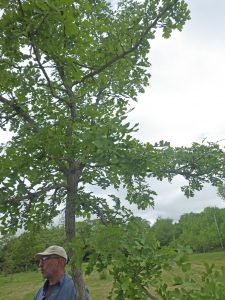
Bur Oak grown horticulturally at Grand Oaks on Grand Lake, Halifax Co., Nova Scotia. It occurs naturally in N.B. and elsewhere on the eastern seaboard, why not in N.S?
There are a dozen species of oak in Massachussetts, while there is only one species (red oak) native to NS. Should we be introducing species from New England to our forests to better adapt to climatic warming?
Nova Scotia is in the same boat, as Prof. Bourque and colleagues reported in a 2010 document prepared for NSDNR on Modelled Potential Species Distribution for Current and Projected Future Climates for the Acadian Forest Region of Nova Scotia, Canada:
“…Results for current and future climates indicate that boreal species in the Acadian forest of NS (e.g., balsam fir, black spruce) would be restricted to the cooler areas of the landscape, i.e., adjacent to cold water bodies (e.g., Bay of Fundy in the northwest and Atlantic Ocean on the south-to-northeast of the province) and high elevation areas, such as the Cape Breton Highlands and Cobequid Hills. Under similar climatic conditions, temperate hardwood species (e.g., red oak, beech) are projected to benefit from elevated GDD in the second (2011-2040) and third tri-decade (2041-2070), and experience some decline in the fourth tri-decade (2071- 2100).”
Should we introduce bur oak (in photo) and other species from New England to Nova Scotia (i.e. conduct “Assisted Migration”) in order to accelerate adaptation to climatic warming? Currently there is little sign NSDNR is paying much attention to climatic warming or at least it is not engaging the public on the issue.
Instead NSDNR continues to promote practices that borealize the Acadian forest (i.e., clear cutting and use of herbicides to promote even age softwoods), which actually reduces adaptation to climatic warming, not to mention adverse effects on wildlife, fish, water retention, susceptibility to fire…
